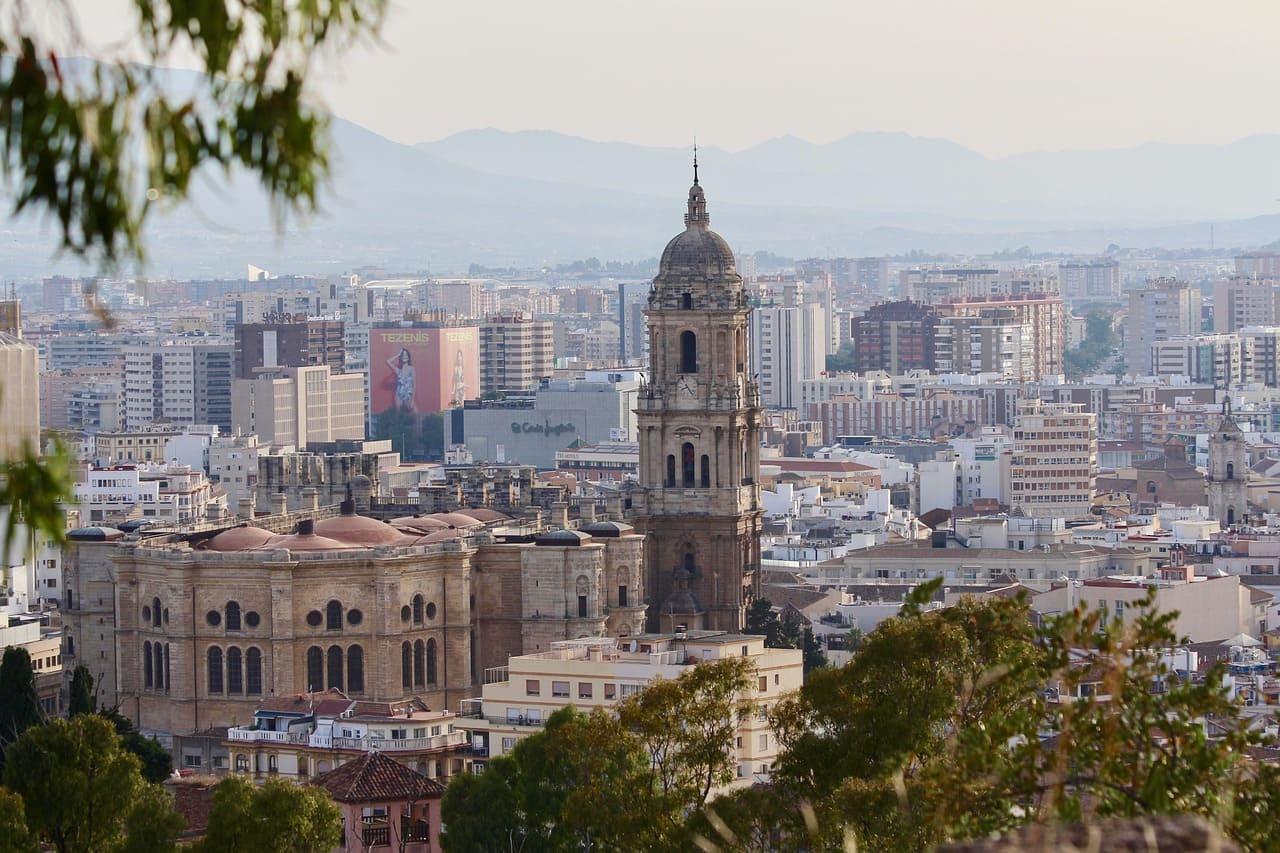Sun-drenched beaches, ancient fortresses, vibrant markets and an artistic soul: Malaga is much more than the gateway to the Costa del Sol. This lively Andalusian city combines centuries of history with a fresh, modern atmosphere that attracts travelers year-round.
Located on Spain’s southern Mediterranean coast, Malaga boasts an enviable climate, delicious cuisine, world-class museums and some of the friendliest locals you’ll ever meet. It is the birthplace of Pablo Picasso, a place where Moorish palaces coexist with avant-garde art centers and where traditional tapas bars bustle until late at night.
Whether you plan a short city break, a longer vacation exploring Andalusia’s treasures or a sunny stop before visiting the nearby beaches, Malaga has something to offer every type of traveler.
In this updated 2025 guide you’ll discover the top things to do in Malaga, Spain: from iconic sights like the Alcazaba and the Roman Theater to local secrets, scenic viewpoints, bustling food markets and unforgettable excursions. Get ready to plan your perfect Malaga itinerary and experience this vibrant city like a true connoisseur.
Historical monuments and panoramic views
Malaga’s rich history is brought to life through its impressive monuments: from ancient fortresses and Roman ruins to grand cathedrals. This is where you can immerse yourself in the city’s fascinating past while enjoying some of the best panoramic views of the Costa del Sol.
Explore the Alcazaba and the Roman Theater
The Alcazaba of Malaga is one of the best preserved Moorish fortresses in Spain, built in the 11th century by the Hammudi dynasty. Situated on a hill overlooking the city, this impressive citadel served as the main defensive structure against pirate attacks from the sea. Today, its sturdy walls, elegant courtyards and fragrant gardens transport visitors back to the Islamic era that shaped much of Andalusia’s identity.
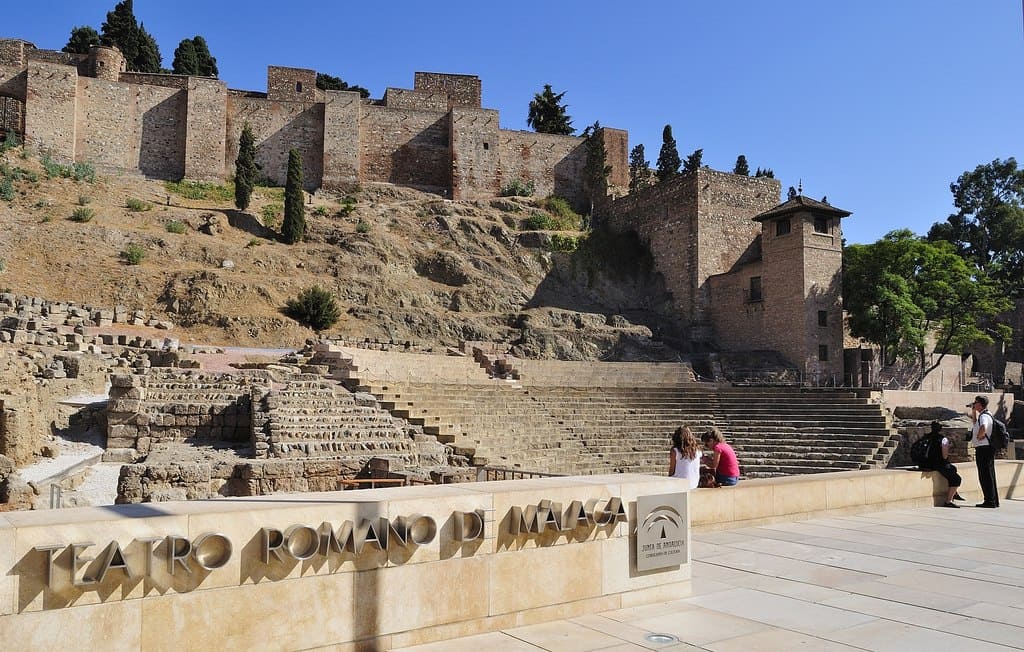
A visit to the Alcazaba usually includes a walk to the connected Gibralfaro Castle (which we’ll talk about next), but first, don’t miss the Roman Theater at its feet. Discovered in 1951 after being hidden for centuries, the Roman Theater of Malaga dates back to the 1st century AD, during the reign of Emperor Augustus. It was used for performances and meetings and is now partially restored for cultural events, with ancient stone seats still visible. Its location just below the Alcazaba highlights how layers of Malaga’s history coexist in one impressive location.
Gibralfaro Castle and scenic viewpoints
Rising 130 meters above the city, Gibralfaro Castle offers the best panoramic views of Malaga and its coastline. Originally built on a Phoenician lighthouse, the fortress was reinforced by the Nasrid ruler Yusuf I in the 14th century to protect the Alcazaba below. The name of the castle comes from the Arabic “Yabal-Faruk”, meaning “rock of the lighthouse”.
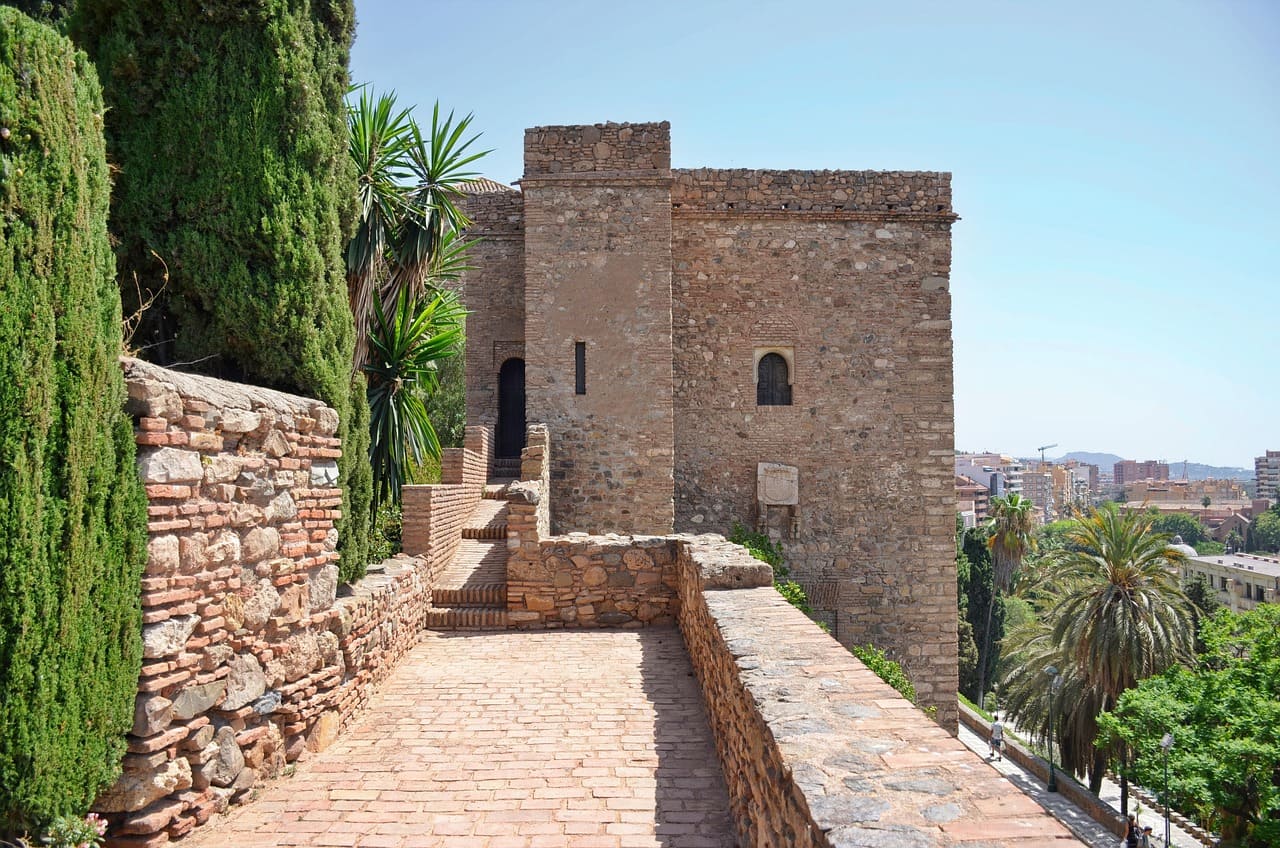
Visitors can stroll along the ancient walls, explore small exhibits inside, and enjoy 360-degree views of the port, the bullring, and the glittering Mediterranean. It’s especially magical at sunset, when Malaga’s sky lights up with shades of orange and pink: an ideal time for stunning photos and a quiet escape from the hustle and bustle of the city.
Marvel at Malaga Cathedral
Nicknamed “La Manquita” because of its unfinished second tower, Malaga Cathedral is a masterpiece of Renaissance and Baroque architecture. Its construction began in the early 16th century on the site of a former mosque and continued for more than 200 years, resulting in a fascinating mix of styles.
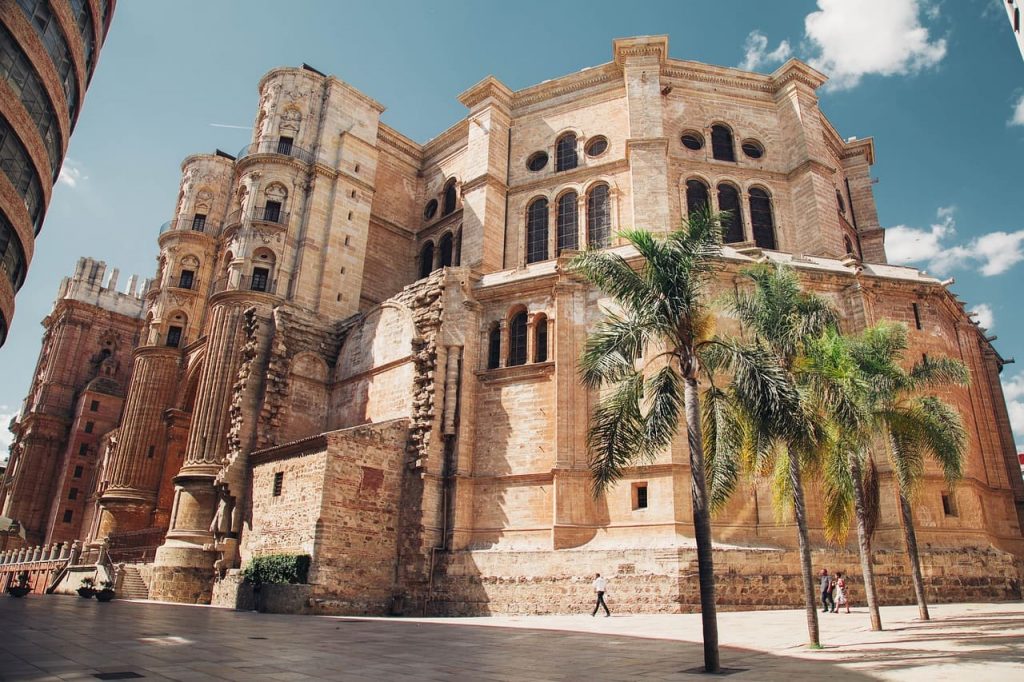
The cathedral’s ornate facade, grandiose interior with marble columns and impressive choir stalls make it one of the most visited monuments in the city. Don’t miss the opportunity to climb to the roof of the cathedral to enjoy unique views of the historic center of Malaga, the port and the surrounding mountains. It’s a perfect combination of art, history and breathtaking cityscapes in an iconic building.
World-class museums and art
Malaga has firmly earned its reputation as a city of culture and creativity. Beyond its historic monuments, it offers an impressive collection of museums and galleries that celebrate both its rich heritage and its contemporary side. Here are the must-see places for art and culture lovers.
Picasso Museum and Birthplace
No trip to Malaga is complete without exploring the legacy of its most famous son, Pablo Picasso. The Museo Picasso Málaga is located in the heart of the historic center, perfectly positioned between the Roman Theater and the Cathedral. Inaugurated in 2003, it houses more than 200 works spanning the artist’s groundbreaking career, from early sketches to later masterpieces.
Just a short walk away is the Casa Natal Picasso, in the Plaza de la Merced. This small but fascinating museum offers an intimate look at the artist’s family life and early years in Malaga, displaying personal objects, family photos and early works. Together, these sites offer a deep dive into the mind of one of the greatest artists of the 20th century.
Museo Carmen Thyssen and Centre Pompidou Málaga
Art enthusiasts will also want to visit the Carmen Thyssen Museum, housed in a beautifully restored 16th-century palace near the city’s main shopping streets. This museum focuses on 19th-century Spanish painting, with a special emphasis on Andalusian costumbrismo: vivid scenes of daily life in the region. Highlights include works by Sorolla, Zuloaga and other masters of Spanish realism.
For a striking contrast, head to Malaga’s modern port area to discover the Centre Pompidou Malaga, instantly recognizable by its colorful glass cube. This vibrant home of Paris’ iconic Centre Pompidou showcases a rotating selection of modern and contemporary artworks, with big names like Frida Kahlo, Miró and Picasso himself. Interactive exhibitions and temporary displays keep the experience fresh and dynamic, making it a must-see for avant-garde art lovers.
Museum of Malaga and other cultural spaces
Housed in the majestic Palacio de la Aduana, the Museum of Malaga is one of the largest in Andalusia and combines two collections under one roof: fine arts and archeology. Visitors can admire everything from Roman mosaics and Phoenician artifacts to works by Spanish masters such as Murillo and Sorolla. The building itself, with its elegant courtyard and marble staircase, is a work of art in itself.
Malaga’s vibrant museum scene doesn’t end there. For something different, visit the Museum of Glass and Crystal, which displays an exquisite private collection of decorative glassware in a charmingly restored mansion. Car enthusiasts will love the Museo del Automóvil y la Moda, which showcases classic cars alongside haute couture pieces. Flamenco fans should not miss the Museum of Flamenco Art, dedicated to this passionate dance that is an essential part of Andalusian culture.
Markets, squares and urban life
Beyond its monuments and museums, Malaga’s daily life is breathed in its bustling markets, historic squares, trendy neighborhoods and seaside promenades. Here’s how to soak up its authentic atmosphere like a true local.
Experience in the Atarazanas Market
No visit to Malaga is complete without a trip to the vibrant Mercado de Atarazanas (Central Market of Atarazanas). Housed in a beautifully restored 19th century iron and glass building, the market’s main entrance still retains an impressive Moorish arch, a relic of the 14th century shipyard that once occupied this site.
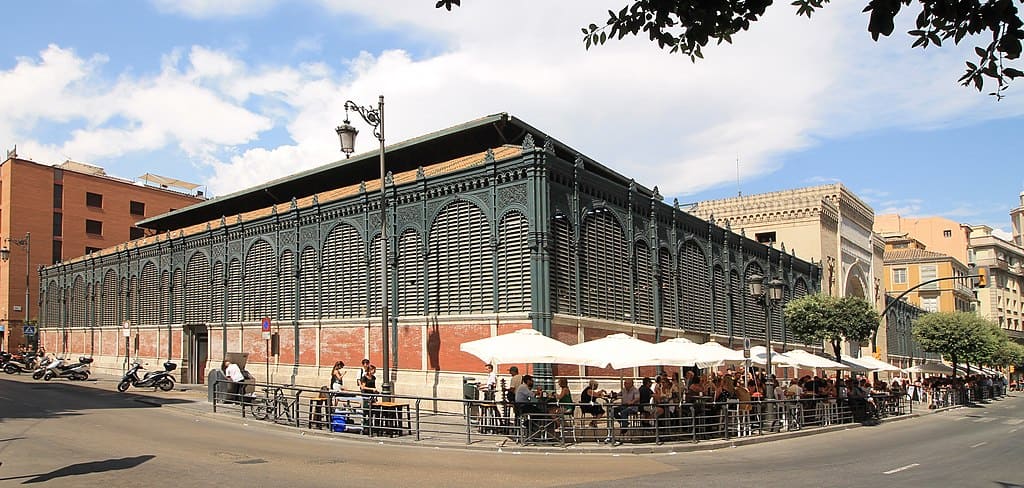
Inside, the market brims with energy: locals chat with vendors, fresh seafood glistens on ice, and colorful piles of seasonal fruits and vegetables overflow from wooden crates. It’s the perfect place to savor Malaga’s food scene, from meaty olives and Iberian ham to freshly grilled fish at the market’s popular tapas bars. For an authentic experience, try a snack and a glass of local wine while watching the comings and goings of Malaga life.
Historic squares and Soho neighborhood
The historic heart of Malaga is dotted with lively squares that invite you to stop and watch life go by. Plaza de la Constitución is the city’s main square and a popular meeting point. Surrounded by elegant historic buildings, lively cafes and boutique stores, it often hosts cultural events, Christmas lights and public celebrations throughout the year.
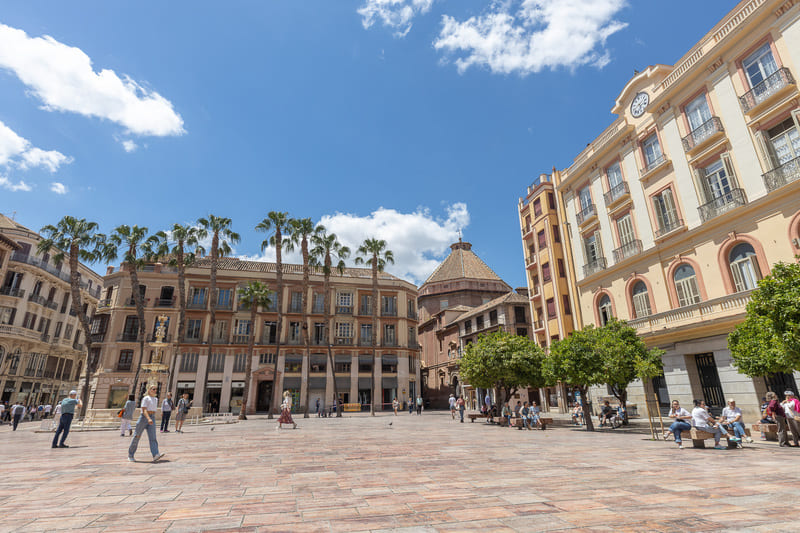
Just a few steps away is Soho Malaga, the most alternative artistic district of the city. Formerly a run-down area, Soho has been transformed into an open-air gallery thanks to large street murals by world-renowned artists such as Obey and D*Face. The area is also home to independent galleries, creative studios and hip cafés, making it a favorite meeting place for Malaga’s youth and artistic community.
Port, beaches and promenade
One of Malaga’s greatest charms is how the city effortlessly merges from its historic streets to the sea. Muelle Uno, the port’s modern promenade, is a lively waterfront space lined with stores, restaurants and outdoor terraces. It’s perfect for a sunset stroll with views of the cathedral dome and the yachts bobbing in the marina.
Strolling through the Palmeral de las Sorpresas, a shady path lined with palm trees, gardens and playgrounds, you will reach Malaga’s beloved urban beaches. La Malagueta Beach, just a 10-minute walk from the old town, is the most popular place to sunbathe and take a dip. Along the sand you will find chiringuitos (beach bars) serving freshly grilled sardines on espetos, a local delicacy not to be missed.
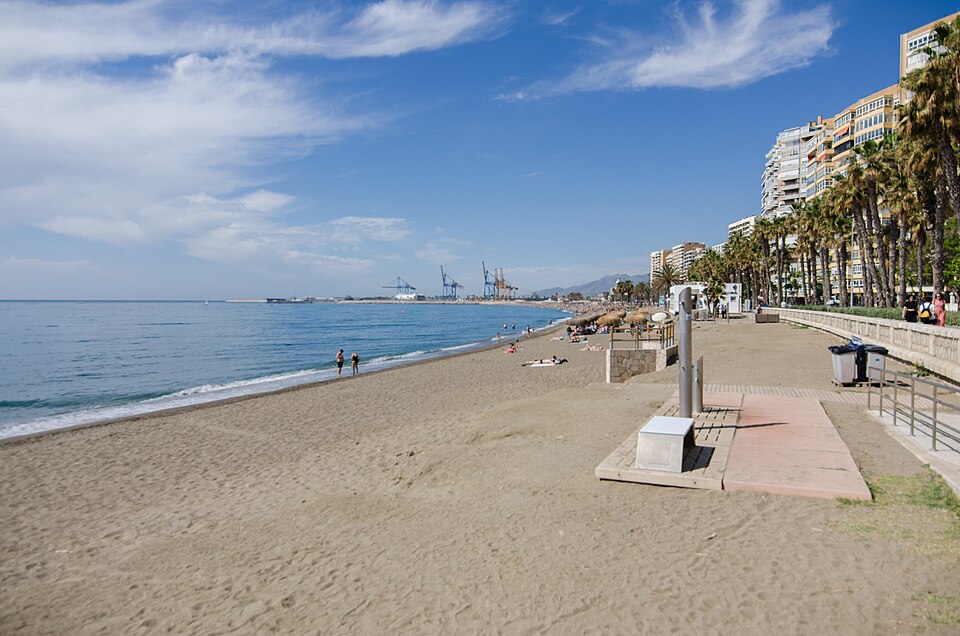
Whether shopping at the port, watching life in the squares or relaxing by the sea, Malaga’s urban life combines relaxation and excitement in equal parts.
Day trips and active adventures
While Malaga is packed with places to see and things to do, it is also the perfect base for exploring some of Andalusia’s most impressive natural wonders and charming villages. Here are some unforgettable excursions and outdoor adventures to add to your itinerary.
Caminito del Rey and surroundings
Once known as the most dangerous trail in the world, the Caminito del Rey is now one of the most exciting hiking trails in Spain – and totally safe. This spectacular 7.7-kilometer route winds along the sheer walls of the Desfiladero de los Gaitanes, suspended high above the Guadalhorce River.
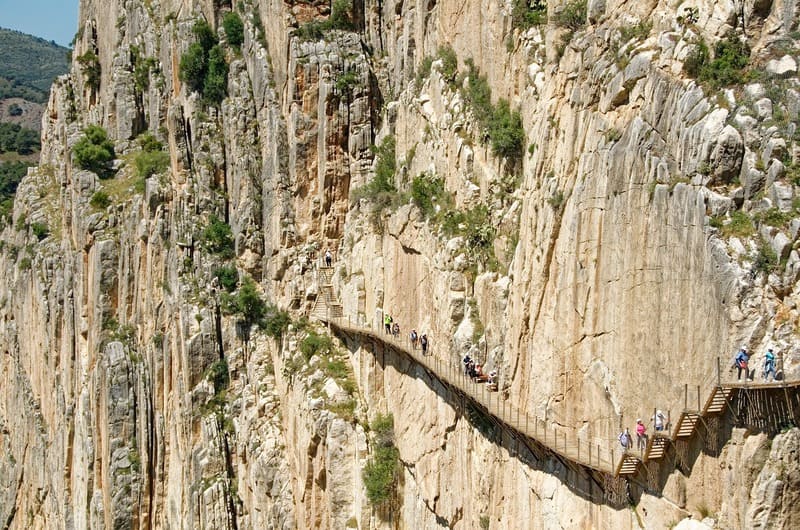
Originally built in the early 20th century as a maintenance path for a hydroelectric dam, the trail owes its name to King Alfonso XIII, who crossed it in 1921. After extensive restoration, the Caminito reopened in 2015 with safe wooden walkways, sturdy railings and breathtaking viewpoints. Expect dramatic cliffs, turquoise waters and an unforgettable dose of adrenaline. It is recommended to visit with a guide and book tickets in advance, as access is limited.
The Torcal de Antequera and surroundings
For a completely different landscape, head some 50 kilometers north of Malaga to discover El Torcal de Antequera, one of the most impressive karst natural parks in Europe. Famous for its surreal limestone rock formations sculpted over millions of years by erosion, El Torcal looks like something out of another planet.
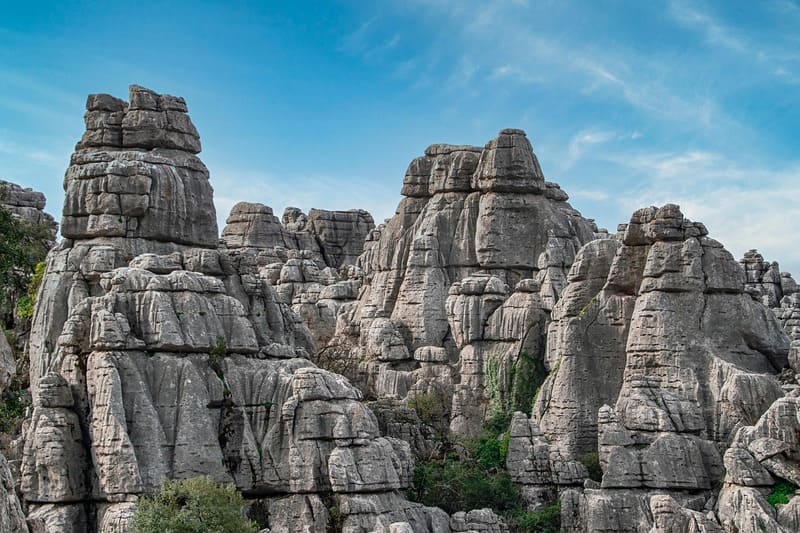
The marked trails range from easy to moderate routes, allowing visitors to meander through narrow passages, admire natural rock sculptures and enjoy panoramic views of the surrounding countryside. Wildlife sightings, such as mountain goats and griffon vultures, are also common. It is a peaceful getaway for nature lovers and photography enthusiasts.
Other excursions: Nerja caves, Ronda and white villages.
If you have more time, consider exploring other gems of the region:
- Nerja Caves: Located about 50 minutes east of Malaga, these spectacular caverns stretch for almost 5 kilometers and feature huge halls, impressive stalactites and stalagmites, and one of the largest natural columns in the world. Guided tours show prehistoric paintings and, on occasion, acoustic concerts are held in the main chamber.
- Ronda: Perched dramatically above a deep gorge, Ronda is one of Andalusia’s most famous white villages. Among its highlights are the iconic Puente Nuevo bridge, the historic bullring and breathtaking views from the top of the cliff. It is a must-see for its combination of dramatic scenery and rich history.
- White villages: Scattered throughout the nearby mountains, these picturesque villages – such as Mijas, Frigiliana and Casares – are characterized by cobblestone streets, whitewashed houses and colorful flowerpots. They offer a charming glimpse into traditional Andalusian life and are perfect for a relaxing day trip.
The best of gastronomy: The best restaurants in Malaga
A visit to Malaga is not only a delight for the eyes, but also for the palate. The city, known for its relaxed atmosphere and vibrant nightlife, offers a unique blend of tradition and modernity in its gastronomic offerings. Whether enjoying local tapas or immersing yourself in a more elaborate culinary experience, Malaga has something for everyone.
Enjoy tapas and local cuisine
Malaga’s cuisine is characterized by fresh Mediterranean ingredients and authentic flavors. If you want to explore the essence of the local gastronomy, there is no better way than enjoying tapas in some of the best establishments in the city.
Start your gastronomic adventure at Cambaraa restaurant that stands out for its Mediterranean cuisine with an innovative touch. In this cozy place, you can taste traditional dishes with a modern twist, prepared with products of the highest quality. Enjoy a modern and elegant atmosphere, ideal for a unique dining experience.
Another restaurant not to be missed is Belugalocated in the heart of Malaga, which offers a high level gastronomic proposal with a focus on fresh and seasonal products. The atmosphere at Beluga is sophisticated yet cozy, making it the perfect place for a special dinner or a meal with friends.
For a more informal but equally delicious experience, La Tasquita is an excellent choice. With a menu based on creative tapas and a selection of local wines, this small but cozy restaurant is perfect for enjoying authentic Malaga cuisine in a relaxed and friendly atmosphere.
If you’re looking for something a little more innovative, we recommend Kraken Malaga. This restaurant stands out for its different gastronomic proposal, with a focus on contemporary flavors and a presentation that will make each dish a work of art. Kraken’s modern atmosphere is ideal for those who want a unique culinary experience in a cozy space.
Malaga by night
When the sun goes down, Malaga comes alive and becomes the perfect place to enjoy an unforgettable night out. The city offers a variety of bars and restaurants where you can enjoy cocktails, dinners and, of course, the vibrant nightlife.
If you are looking for a place with a more intimate and elegant atmosphere, Salao Malaga is an excellent choice. With its sophisticated decor and innovative culinary proposal, it is the ideal place to enjoy a quiet dinner or a cocktail while enjoying the night view of the city.
And if what you prefer is a place with an even more vibrant atmosphere, Lolita Malaga is the perfect place. With its casual atmosphere and its quality gastronomic proposal, it is an excellent meeting point to enjoy the local cuisine accompanied by a good wine or cocktail.
Malaga by night and flamenco
At nightfall, the historic center of Malaga is transformed into the beating heart of nightlife. Terraces and squares filled with people enjoying tapas and drinks under the stars. The most popular nightlife areas include Plaza Uncibay and its surroundings, where you can enjoy the gastronomic offer and the lively nightlife.
For those looking for a touch of culture, you can’t miss a flamenco show, either in a traditional tablao or in a more modern setting. The passion of flamenco and the unique atmosphere of Malaga will create an unforgettable experience.
Whether enjoying a dinner with friends, having a drink on a terrace or letting yourself be carried away by the excitement of flamenco, Malaga’s nightlife will leave you with memories you will never forget.
The best of each season and practical information
Before packing your bags, it’s a good idea to know when to visit Malaga and how to get around easily. Here’s a quick guide to make the most of your stay, whatever the season.
Best time to visit and climate
Malaga enjoys one of the mildest climates in Europe. With more than 300 days of sunshine a year, it is a year-round destination, but each season has its own special charm.
- Spring (March to May): Pleasant temperatures and gardens in bloom make this a perfect time for sightseeing without crowds. Semana Santa is Malaga’s biggest religious celebration, filling the streets with elaborate processions and traditional music.
- Summer (June to August): Lots of sun and lively beach days. August is party season: the famous Feria de Málaga turns the whole city into a week-long street party with dances, concerts and fair – a real highlight for those who want to experience Andalusian culture at its best.
- Autumn (September to November): Warm days linger and crowds thin, ideal for exploring museums and enjoying local cuisine.
- Winter (December to February): Even in the coldest months, daytime temperatures usually exceed 15 °C. Malaga is illuminated with festive Christmas lights and cultural events such as the Malaga Theater Festival, which add a magical touch to its streets.
No matter when you come, Malaga’s welcoming atmosphere and mild climate guarantee a pleasant trip.
Transportation tips and recommendations for visitors
Getting around Malaga is easy and affordable, making it easy to visit the main attractions and make excursions nearby.
In the city:
- Most of the places of interest in the historic center are within walking distance.
- To go up to the Gibralfaro Castle, local buses (such as line 35) leave frequently from the center.
- Cabs and car-sharing services are widely available, and the city’s bicycle rental system is a fun and environmentally friendly option for exploring the harbor and beach areas.
Day trips:
- If you plan to walk the Caminito del Rey, there are regular trains connecting Malaga with the nearby town of El Chorro; from there, shuttle buses take you to the entrance of the trail. Book tickets in advance, especially in high season.
- For longer trips, Malaga’s modern train and bus stations offer easy links to other Andalusian gems such as Ronda, Granada and Seville.
Practical advice:
- Many museums and attractions offer discounts for online purchase – check the official websites before your visit.
- English is widely spoken in the tourist areas, but learning some basic Spanish phrases is always appreciated.
- Malaga is very safe, but as in any city, watch your belongings in crowded areas.
With a little planning, you can relax and focus on enjoying all the beauty and culture this sunny city has to offer.
Itinerary tips
Whether you have just one day or a long weekend, Malaga is ready to fill your trip with unforgettable experiences. Here is a suggested itinerary to make the most of your time in this sun-drenched city:
If you have 1 day:
Concentrate on the historic center – visit the Alcazaba and the Roman Theater in the morning, admire the Cathedral and stroll through the Atarazanas Market for a bite to eat. Spend the afternoon relaxing on La Malagueta Beach or exploring the vibrant streets of Soho.
If you have 2 days:
Add the Picasso Museum and a few more artistic stops such as the Carmen Thyssen Museum or the Centre Pompidou Malaga. In the evening, indulge yourself with tapas in a local tavern and enjoy a live flamenco show for an authentic Andalusian night.
If you have 3 days:
Take a day trip: walk the exciting Caminito del Rey, explore the surreal rock formations of El Torcal de Antequera, or visit the impressive Nerja Caves. You can also take the opportunity to enjoy Malaga’s modern port and lively squares at a more leisurely pace.

